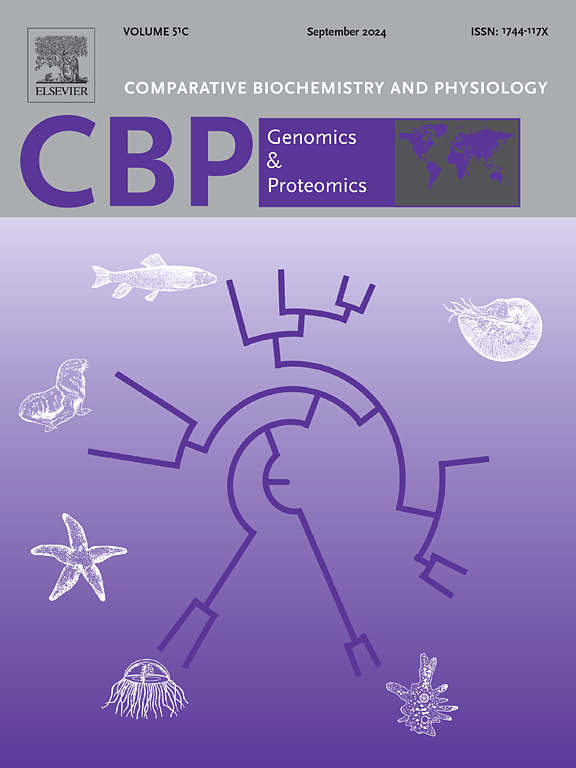转录组分析阐明了交配会影响卵巢内/外因子的表达,从而影响泥蟹Scylla paramamosain的卵巢发育。
IF 2.2
2区 生物学
Q4 BIOCHEMISTRY & MOLECULAR BIOLOGY
Comparative Biochemistry and Physiology D-Genomics & Proteomics
Pub Date : 2024-09-28
DOI:10.1016/j.cbd.2024.101334
引用次数: 0
摘要
在青春期蜕皮和交配之前,泥蟹Scylla paramamosain的卵巢发育主要处于第二阶段。然而,交配后,雌蟹立即开始卵黄发生,卵巢迅速发育。本研究的目的是鉴定交配前后与泥蟹卵巢发育相关的差异表达基因,从而利用比较转录组学阐明交配对卵巢发育的影响。KEGG通路分析结果表明,在两个转录组中,核糖体和核糖体相关通路与卵巢第二阶段的发育高度相关,可能通过提供必要的材料来支持后续的卵黄发生。此外,神经变性、MAPK、cAMP 和 PLD 通路在交配后调节卵原细胞分化、卵母细胞增殖和卵黄发生方面也很活跃。同时,某些卵巢内因子,如细胞周期相关基因cyclin B和APC、叉头盒家族基因Foxl2和slp1、SOX家族基因SOX5-like、激素相关基因SULT1E1和Eip74EF-like、生长因子相关基因VEGFD-like和CUBE1-like以及HPS10和tra1-like等,在交配后对卵巢发育具有重要的调控作用。此外,RPCHR、HR4 和 ILR1 等卵巢外激素受体以及神经递质受体 5-HTR4 也参与了卵巢的发育。研究认为,卵巢发育受内在和外在内分泌因素的协调作用控制,而这些因素又受交配的影响。最后,表观遗传修饰相关基因、转录因子和靶基因的分析揭示了基因表达的调控。我们的研究表明,这些基因以协调的方式调节卵巢发育过程中卵泡细胞发育、卵原细胞分化、卵母细胞增殖和卵黄发生等复杂过程。本文章由计算机程序翻译,如有差异,请以英文原文为准。

Transcriptome analysis elucidates mating affects the expression of intra-/extra-ovarian factors, thereby influencing ovarian development in the mud crab Scylla paramamosain
Prior to the pubertal molt and mating, the ovarian development of the mud crab Scylla paramamosain was primarily at stage II. However, immediately after mating, female crabs initiate vitellogenesis, and their ovaries quickly develop. The aim of this study was to identify differentially expressed genes associated with ovarian development in the mud crab before and after mating, in order to elucidate the influence of mating on ovarian development using comparative transcriptomics. The KEGG pathway analysis results indicated that ribosome and ribosome-related pathways were highly associated with ovarian development at stage II across both transcriptomes, likely to support the subsequent vitellogenesis by providing the necessary materials. Additionally, the neurodegeneration, MAPK, cAMP and PLD pathways were active in regulating oogonia differentiation, oocyte proliferation and vitellogenesis after mating. Meanwhile, certain intra-ovarian factors, such as the cell cycle-related genes cyclin B and APC, the forkhead box family genes Foxl2 and slp1, the SOX family gene SOX5-like, the hormone-related genes SULT1E1 and Eip74EF-like, the growth factor-related genes VEGFD-like and CUBE1-like, as well as HPS10 and tra1-like, have essential functions in regulating ovarian development after mating. Furthermore, the receptors of extra-ovarian hormones, such as RPCHR, HR4, and ILR1, as well as the neurotransmitter receptor 5-HTR4, were involved in ovarian development. It is believed that ovarian development is controlled by the coordinated action of both intrinsic and extrinsic endocrine factors, and these factors are influenced by mating. Finally, the analysis of epigenic modification-related genes, transcription factors, and target genes revealed the regulation of gene expression. Our study indicated that, those genes work in a coordinated manner to regulate the complex processes of follicle cell development, oogonia differentiation, oocyte proliferation, and vitellogenesis during ovarian development.
求助全文
通过发布文献求助,成功后即可免费获取论文全文。
去求助
来源期刊
CiteScore
5.10
自引率
3.30%
发文量
69
审稿时长
33 days
期刊介绍:
Comparative Biochemistry & Physiology (CBP) publishes papers in comparative, environmental and evolutionary physiology.
Part D: Genomics and Proteomics (CBPD), focuses on “omics” approaches to physiology, including comparative and functional genomics, metagenomics, transcriptomics, proteomics, metabolomics, and lipidomics. Most studies employ “omics” and/or system biology to test specific hypotheses about molecular and biochemical mechanisms underlying physiological responses to the environment. We encourage papers that address fundamental questions in comparative physiology and biochemistry rather than studies with a focus that is purely technical, methodological or descriptive in nature.

 求助内容:
求助内容: 应助结果提醒方式:
应助结果提醒方式:


